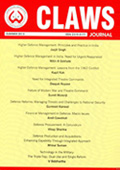|
Foreign Minister Yang Jeichi’s three-day visit to India commenced on 7 September 2008 with the inauguration of a Chinese Consulate at Kolkatta, which the Foreign Minister lauded as a symbol of deepening relations between the two countries. The Foreign Minster also met with Prime Minister Manmohan Singh and Minister for External Affairs Pranab Mukherjee in New Delhi. The bilateral talks centred on the long-standing border row, in which India claims that China occupies 38,000 square kilometres (14,700 square miles) of territory in the Aksai Chin region of Ladakh, whilst China lays claim to the Indian state of Arunachal Pradesh.
The border region has been a bone of contention for years, with the infamous Sino-Indian War of 1962 still firmly etched in political calculations on both sides of the McMahon Line. Thus far, eleven rounds of talks have been held to seek a solution to the dispute. With China’s doctrine of ‘Peaceful Rise’ on the global scenario, resolving the border dispute with India is increasingly important. Coupled with suspicions over New Delhi’s implicit support to the cause of Tibet, Beijing has sought to allay fears of a regional rivalry between the two countries by bringing contentious issues to the table. This gesture towards dialogue suggests China might be seeking to trade in its conventional position of strength attitude for a more accommodative and reconciliatory posture.
But there are two other issues that must be tackled first. Foreign Minister Yang’s visit follows India’s bid for a nuclear waiver at the Nuclear Suppliers Group meeting at Vienna, where India succeeded in securing trading rights for nuclear technology and fuel meant for civilian purposes. However, the Indian delegation expressed disappointment with China for its stance at this meeting of the NSG, which is the regulatory body for global atomic commerce, on allowing India to join civilian nuclear trade. It was alleged that China did not seem keen on lifting this ban, but the Foreign Minister decried this alleged reluctance, claiming instead that China hadn’t blocked the bid; instead he stressed China had played a “constructive role” in the process. While this issue might now be mute, it is important that any Chinese fears be allayed with assurances of better diplomatic relations and increased economic engagement. As two rising economic powers, the Chinese have acknowledged further economic and trade-related syncretism. Indeed, during Prime Minister Manmohan Singh’s visit to China in January this year, the two sides agreed to lift the target for bilateral trade to USD 60 billion by 2010 (it had risen to USD 38.7 billion in 2007).
Secondly, now that the Indo-US Nuclear Deal has gained momentum again, the prospects of a Sino-Pakistani nuclear deal must be re-examined. Pakistan has failed to meet its growing energy needs and the crisis has worsened since November 2007. While Pakistan is engaged in a debate over the suitability of an energy deal to meet its requirements, the United States refused an agreement similar to the Indo-US Nuclear Deal with Pakistan, citing problems with its proliferation record, the control and stability of its strategic assets and fears akin to the AQ Khan network. It is likely in this scenario that Pakistan will turn to its close co-operator of many decades, China. In the last three years, there have been ten state visits by Pakistani officials to China. Chinese help to Pakistan’s missile programme is well-known. It now remains to be seen if China will openly engage in nuclear trade with Pakistan, at the cost of upsetting the United States and alerting India to its intentions.
The play-out of the Chinese stance on the nuclear waiver for India at the NSG is telling in this regard. While addressing the Indian side’s suspicions about China’s efforts at sabotaging the waiver at the NSG, Cheng Jingyem, head of the Chinese delegation, pointed out that it was Beijing’s hope that the decision made by the NSG would stand the test of time and contribute to the goal of nuclear non-proliferation and peaceful use of atomic power. Chinese newspaper, the People’s Daily reported Cheng as saying, "It is also China's hope that NSG will equally address the aspirations of all parties for the peaceful use of nuclear power while adhering to the nuclear non-proliferation mechanism". This is a clear indicator of Chinese desire to open up trade with Pakistan for its nuclear energy. In New Delhi, this reference is viewed as typically Chinese positioning of Pakistan as a counterweight to India. Indeed, the denial of a meeting for Minister Yang with Congress President Sonia Gandhi was illustrative of the deep disappointment that has pervaded the political atmosphere in India towards China’s duplicitous stand at the NSG and in its relations with India vis-à-vis Pakistan.
Given recent American discourse about Indo-American strategic partnership in the run-up to the Nuclear Deal and the rejection of cooperation with Pakistan at the nuclear haves club, it is facile to discern further alliance between China and Pakistan. For India, such an alliance could be worrisome. With a newly elected and unstable democracy in Pakistan and the lingering problems of insurgency and terrorism on its western borders, India must move urgently to resolve the border disputes with its northern neighbour. An alliance between two problematic neighbouring states could very well turn against India – if not on an international forum, it might in regional theatres of conflict.
A number of high-level visits between the two sides have taken place in the last four years, including one by President Hu Jintao and another by Chinese Prime Minister Wen Jiabao. But none have yielded much ground for any commonalities to formalize into bilateral cooperation outside the economic realm. Instead, Foreign Minister Yang’s visit received much criticism in the Indian press and amongst Indian polity. Whilst the Congress demonstrated its resentment at China’s exercise of shrewd realpolitik at the NSG, the media continuously raised questions about the current status of the Sino-Indian relationship. Perhaps it is an opportune moment for India to adopt a revisionist attitude, to assert its regional responsibilities and to avert a diplomatic encore of 1962.
(Disclaimer: The views expressed in this article are those of the author and do not represent the views either of the Editorial Committee or the Centre for Land Warfare Studies)
|



